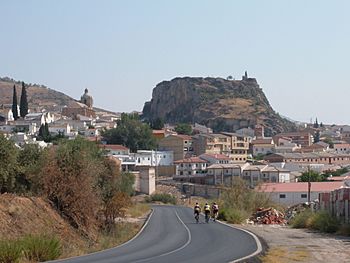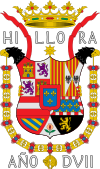Íllora facts for kids
Quick facts for kids
Íllora
|
||
|---|---|---|
|
Municipality
|
||

Íllora
|
||
|
||
| Country | Spain | |
| Autonomous Community | Andalusia | |
| Province | Granada | |
| Comarca | Comarca de Loja | |
| Area | ||
| • Total | 197.4 km2 (76.2 sq mi) | |
| Elevation
(AMSL)
|
759 m (2,490 ft) | |
| Population
(2018)
|
||
| • Total | 10,135 | |
| • Density | 51.342/km2 (132.98/sq mi) | |
| Time zone | UTC+1 (CET) | |
| • Summer (DST) | UTC+2 (CEST (GMT +2)) | |
| Postal code |
18260
|
|
| Area code(s) | +34 (Spain) + 958 (Granada) | |
| Website | www.illora.com | |
Íllora is a town and municipality in the Province of Granada, located in Andalusia, Spain. It is surrounded by several other towns and villages. These include Moclín, Pinos Puente, Valderrubio, Moraleda de Zafayona, Villanueva Mesía, Montefrío, and Alcalá la Real. The municipality of Íllora itself includes several smaller areas like Alomartes, Tocón, and Escóznar.
The main way people in Íllora earn money is through farming. They especially focus on growing olives, which are very important for the local economy.
Contents
Demography: How Many People Live Here?
Demography is the study of how populations change over time. Íllora has had a population of around 10,000 people in recent years. For example, in 2018, about 10,135 people lived there.
Toponymy: What's in a Name?
The name Íllora comes from an old word, "Illurco." Experts like Wilhelm von Humboldt think this word might be from the Basque language. It could also come from an ancient Pyrenean town. This is why people from Íllora are sometimes called "Ilurquense." For many centuries, from the 1400s to the 1800s, the name was often written as "Yllora" with a "Y."
Symbols: The Town's Shield
The local council of Íllora has used a special shield as its symbol for a long time. This design has been in use since 1720. It became the town's symbol when the area became part of the royal state under King Philip V.
The shield shows symbols from different kingdoms. These include Castile and León, Aragón-Sicilia, Austria, and Burgundy. It also has symbols for Brabant and Granada. In the middle, there is a small shield for the Borbón-Anjou family. A special necklace, called the Toisón de Oro, is also part of the design.
The shield has some unique features. There are small, quick-looking heads in the top corners. A star is in the middle of the top edge. The words "Hillora" and "year D'VII" are written above and below the shield. Historians are not sure what "507" means. It might refer to the year the town was founded. The extra "H" in "Hillora" is also a mystery. Some think it was added just to make the word look more balanced.
History: A Look Back in Time
Early Times: Prehistory to Romans
People have lived in Íllora for a very long time. Archaeologists have found things from the Stone Age (Neolithic period) and the Copper Age. Around 600 BC, the Carthaginians arrived in Spain. They took control from the Phoenicians and built their empire, which included the area of Illurco.
Later, the Romans came. They built new settlements in places where villages already existed. The Roman writer Pliny mentioned Illurco as one of the important towns in the area.
Muslim Rule and Reconquest
There isn't much information about Íllora during the Muslim rule. However, Christian writings suggest it was an important town with a strong fortress. In 1319, two princes from Castile, Pedro and Juan, attacked Íllora. They took the town and its outer areas. They wanted to capture the city of Granada. Sadly, both princes died shortly after in a battle near Granada in June 1319.
In 1486, King Ferdinand of Aragon continued the war against Granada. He first captured Loja, which helped him conquer Íllora. On June 8, 1486, the Catholic Monarchs (Ferdinand and Isabella) finally conquered Íllora. They appointed Gonzalo Fernández de Córdoba, known as the Great Captain, as the first Christian leader of the town. This is why the local school is named after him.
After the Reconquista (the Christian reconquest of Spain), the land changed hands. The original Muslim owners left, and Christians took over. The economy was mainly based on subsistence agriculture. People grew wheat and barley to feed themselves.
19th Century Challenges
The early 1800s were mostly peaceful for Íllora. But then the Spanish War of Independence began, caused by the French invasion. The people of Íllora did not like the French. They supported the uprising against the French and many joined the fight. The region suffered a lot from looting by the French soldiers.
When King Fernando VII returned, Íllora started to recover. However, there were new conflicts between different political groups in Spain. Íllora remained loyal to the authorities during some of these conflicts.
Culture: Arts and Traditions
Museums: Places to Learn
- Pósito del Trigo: This building has a beautiful neoclassical style. It was built in 1738 and is now a museum.
- Molino: This is a museum located in Alomartes, one of Íllora's villages.
Historical Heritage: Old Buildings and Towers
In the center of Íllora, on top of a rock, you can find the ruins of the old castle. Not much of the original walls are left. This castle was built during the Caliphate period (9th-10th centuries). It had three main parts: the town, the fortress, and the outer area.
Near the castle, there are several old watchtowers. These towers were used to send signals. The Tower of Brácana is a famous example. In Tocón, there is another tower that was part of a rural castle. All these towers were built during the Nasrid period.
Íllora also has an important church called Nuestra Señora de la Encarnación. It was designed by Diego de Siloé in the 16th century. He also designed the Granada Cathedral. This church is considered a very important cultural monument.
Music: Parapanda Folk Festival
The most important music event in Íllora is the Parapanda Folk festival. It is a big deal for tourists and takes place in the last week of July. Both Spanish and international music groups perform there. It is a very important cultural event for the town.
Festivities: Celebrations and Holidays
- Saint Rogelio Festival: The town celebrates its patron saint, Saint Rogelio, on the third weekend of August. The actual day of Saint Rogelio is September 16th, which is also a holiday in the village.
- Local Fair: The local fair happens from October 8th to 12th. Long ago, it was one of the most important fairs in all of Spain.
- Easter: This is a very important week for culture and religion. From Palm Sunday to Easter Sunday, there are many events. The local church and four religious groups organize these celebrations.
Sports: Staying Active
The main football team in Íllora is the Sports Union of Íllora (UD Íllora). They play at the La Laguna Sports Complex. Since 2011, their football field, named Antonio García "El Calvo," has a 2-star artificial turf. This is a high rating from FIFA. The younger teams are called UD Parapanda. There are also futsal (indoor football) teams that play at the municipal pavilion.
If you like mountain biking, there is an association called Gallipatos de Parapanda. They organize mountain biking activities and competitions.
Gastronomy: Delicious Local Food
The traditional food in Íllora often uses old ways of preserving food. One popular method is keeping meat in olive oil. This is used to make many well-known stews, called guisos. A special local dish is asparagus in sauce.
Well-known Figures: Famous People from Íllora
- Saint Rogelio (9th century): A monk and martyr.
- Juan Bautista Sánchez González (1893–1957): A soldier who fought in wars and became a high-ranking general.
- José Francisco Lorca Navarrete (1944–2000): A respected professor.
- José Eduardo González Navas (1951): A politician.
- Nicolás Jiménez Molina (1896): A politician.
- Guillermo Campos Jiménez (1965): An artist known as Morenito de Íllora, famous for flamenco singing.
See also
 In Spanish: Íllora para niños
In Spanish: Íllora para niños



